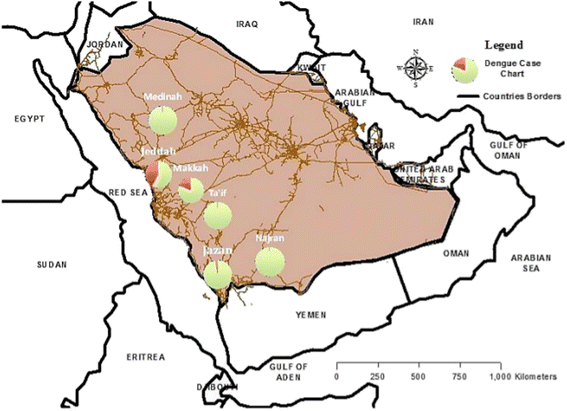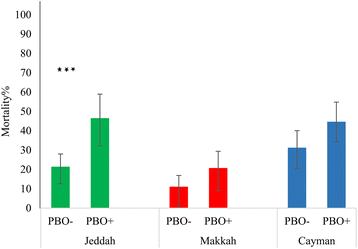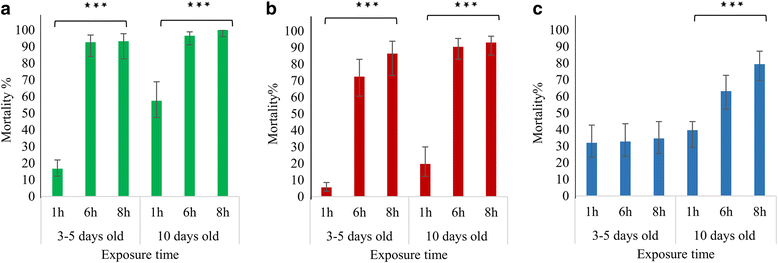Combined target site (kdr) mutations play a primary role in highly pyrethroid resistant phenotypes of Aedes aegypti from Saudi Arabia
- PMID: 28347352
- PMCID: PMC5368989
- DOI: 10.1186/s13071-017-2096-6
Combined target site (kdr) mutations play a primary role in highly pyrethroid resistant phenotypes of Aedes aegypti from Saudi Arabia
Abstract
Background: Pyrethroid resistance is a threat to effective vector control of Aedes aegypti, the vector of dengue, Zika and other arboviruses, but there are many major knowledge gaps on the mechanisms of resistance. In Jeddah and Makkah, the principal dengue-endemic areas of Saudi Arabia, pyrethroids are used widely for Ae. aegypti control but information about resistance remains sparse, and the underlying genetic basis is unknown. Findings from an ongoing study in this internationally significant area are reported here.
Methods: Aedes aegypti collected from each city were raised to adults and assayed for resistance to permethrin, deltamethrin (with and without the synergist piperonyl butoxide, PBO), fenitrothion, and bendiocarb. Two fragments of the voltage-gated sodium channel (Vgsc), encompassing four previously identified mutation sites, were sequenced and subsequently genotyped to determine associations with resistance. Expression of five candidate genes (CYP9J10, CYP9J28, CYP9J32, CYP9M6, ABCB4) previously associated with pyrethroid resistance was compared between assay survivors and controls.
Results: Jeddah and Makkah populations exhibited resistance to multiple insecticides and a similarly high prevalence of resistance to deltamethrin compared to a resistant Cayman strain, with a significant influence of age and exposure duration on survival. PBO pre-exposure increased pyrethroid mortality significantly in the Jeddah, but not the Makkah strain. Three potentially interacting Vgsc mutations were detected: V1016G and S989P were in perfect linkage disequilibrium in each strain and strongly predicted survival, especially in the Makkah strain, but were in negative linkage disequilibrium with 1534C, though some females with the Vgsc triple mutation were detected. The candidate gene CYP9J28 was significantly over-expressed in Jeddah compared to two susceptible reference strains, but none of the candidate genes was consistently up-regulated to a significant level in the Makkah strain.
Conclusions: Despite their proximity, Makkah and Jeddah exhibit significant differences in pyrethroid resistance phenotypes, with some evidence to suggest a different balance of mechanisms, for example with more impact associated with CYP450s in the Jeddah strain, and the dual kdr mutations 989P and 1016G in the more resistant Makkah strain. The results overall demonstrate a major role for paired target site mutations in pyrethroid resistance and highlight their utility for diagnostic monitoring.
Keywords: Aedes aegypti; Dengue; Insecticide resistance; Knockdown resistance; Piperonyl butoxide (PBO); Saudi Arabia.
Figures





Similar articles
-
Voltage-sensitive sodium channel (Vssc) mutations associated with pyrethroid insecticide resistance in Aedes aegypti (L.) from two districts of Jeddah, Kingdom of Saudi Arabia: baseline information for a Wolbachia release program.Parasit Vectors. 2021 Jul 12;14(1):361. doi: 10.1186/s13071-021-04867-3. Parasit Vectors. 2021. PMID: 34247634 Free PMC article.
-
Pyrethroid resistance status and co-occurrence of V1016G, F1534C and S989P mutations in the Aedes aegypti population from two dengue outbreak counties along the China-Myanmar border.Parasit Vectors. 2024 Feb 27;17(1):91. doi: 10.1186/s13071-024-06124-9. Parasit Vectors. 2024. PMID: 38414050 Free PMC article.
-
Molecular analysis of knockdown resistance (kdr) mutations in the voltage-gated sodium channel gene of Aedes aegypti populations from Saudi Arabia.Parasit Vectors. 2022 Oct 19;15(1):375. doi: 10.1186/s13071-022-05525-y. Parasit Vectors. 2022. PMID: 36261845 Free PMC article.
-
Presence of the point mutations Val1016Gly in the voltage-gated sodium channel detected in a single mosquito from Panama.Parasit Vectors. 2019 Jan 28;12(1):62. doi: 10.1186/s13071-019-3309-y. Parasit Vectors. 2019. PMID: 30691518 Free PMC article. Review.
-
Pyrethroid resistance in the dengue vector Aedes aegypti in Southeast Asia: present situation and prospects for management.Parasit Vectors. 2018 Jun 4;11(1):332. doi: 10.1186/s13071-018-2899-0. Parasit Vectors. 2018. PMID: 29866193 Free PMC article. Review.
Cited by
-
Biological comparative study between Wolbachia-infected Aedes aegypti mosquito and Wolbachia-uninfected strain, Jeddah city, Saudi Arabia.Saudi J Biol Sci. 2023 Mar;30(3):103581. doi: 10.1016/j.sjbs.2023.103581. Epub 2023 Feb 2. Saudi J Biol Sci. 2023. PMID: 36844640 Free PMC article.
-
Distribution of insecticide resistance and mechanisms involved in the arbovirus vector Aedes aegypti in Laos and implication for vector control.PLoS Negl Trop Dis. 2019 Dec 12;13(12):e0007852. doi: 10.1371/journal.pntd.0007852. eCollection 2019 Dec. PLoS Negl Trop Dis. 2019. PMID: 31830027 Free PMC article.
-
The F1534C voltage-sensitive sodium channel mutation confers 7- to 16-fold resistance to pyrethroid insecticides in Aedes aegypti.Pest Manag Sci. 2020 Jun;76(6):2251-2259. doi: 10.1002/ps.5763. Epub 2020 Feb 18. Pest Manag Sci. 2020. PMID: 31981401 Free PMC article.
-
Evaluation of the biological efficacy and susceptibility in Aedes aegypti to the pyrethroid insecticides deltamethrin and cyfluthrin during the Zika virus outbreak in Kuna Yala, Panama.Biomedica. 2023 Jun 30;43(2):222-243. doi: 10.7705/biomedica.6746. Biomedica. 2023. PMID: 37433163 Free PMC article. English, Spanish.
-
Insecticide resistance status and high frequency of kdr mutations in Aedes aegypti in Tegucigalpa, Honduras.Parasit Vectors. 2025 Aug 1;18(1):321. doi: 10.1186/s13071-025-06953-2. Parasit Vectors. 2025. PMID: 40751217 Free PMC article.
References
-
- WHO. Dengue guidelines for diagnosis, treatment, prevention and control. WHO. 2009. http://www.who.int/csr/resources/publications/dengue_9789241547871/en/. Accessed 1 Nov 2016. - PubMed
-
- Betancourt-Cravioto M, Kuri-Morales P, Gonzalez-Roldan JF, Tapia-Conyer R, Mexican Dengue Expert G. Introducing a dengue vaccine to Mexico: development of a system for evidence-based public policy recommendations. PLoS Negl Trop Dis. 2014;8(7):e3009. doi: 10.1371/journal.pntd.0003009. - DOI - PMC - PubMed
MeSH terms
Substances
LinkOut - more resources
Full Text Sources
Other Literature Sources
Molecular Biology Databases

